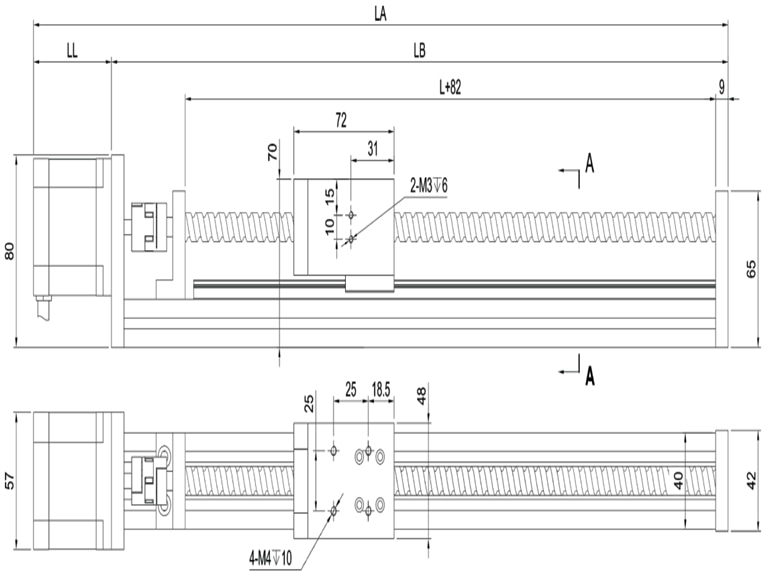A linear actuator moves a load, which can be an assembly, components, or a finished product, in a straight line. It converts energy into a motion or force and can be powered by pressurized fluid or air, as well as electricity.Here is a breakdown of common linear actuators, their advantages and their disadvantages.
How Do They Work?
• Pneumatic linear actuators consist of a piston inside a hollow cylinder. Pressure from an external compressor or manual pump moves the piston inside the cylinder. As pressure increases, the cylinder moves along the axis of the piston, creating a linear force. The piston returns to its original position by either a spring-back force or fluid being supplied to the other side of the piston.
• Hydraulic linear actuators operate similarly to pneumatic actuators, but an incompressible liquid from a pump rather than pressurized air moves the cylinder.
• An electric linear actuator converts electrical energy into torque. An electric motor mechanically connected turns a lead screw. A threaded lead or ball nut with corresponding threads that match those of the screw is prevented from rotating with the screw. When the screw rotates, the nut gets driven along the threads. The direction the nut moves depends on which direction the screw rotates and also returns the actuator to its original position.
【Pneumatic Actuators】
Advantages
• The benefits of pneumatic actuators come from their simplicity. Most pneumatic aluminum actuators have a maximum pressure rating of 150 psi with bore sizes ranging from ? to 8 in., which translate into approximately 30 to 7,500 lb. of force. Steel actuators have a maximum pressure rating of 250 psi with bore sizes ranging from ? to 14 in., and they generate forces ranging from 50 to 38,465 lbf.
• Pneumatic actuators generate precise linear motion by providing accuracy, for example, within 0.1 inches and repeatability within .001 inches.
• Pneumatic actuators typical applications involve areas of extreme temperatures. A typical temperature range is -40°F to 250°F. In terms of safety and inspection, by using air, pneumatic actuators avoid using hazardous materials. They meet explosion protection and machine safety requirements because they create no magnetic interference due to their lack of motors.
• In recent years, pneumatics has seen many advances in miniaturization, materials, and integration with electronics and condition monitoring. The cost of pneumatic actuators is low compared to other actuators. According to Bimba Manufacturing, for example, the average pneumatic actuator costs $50 to $150. Pneumatic actuators are also lightweight, require minimal maintenance, and have durable components that make pneumatics a cost-effective method of linear motion.
Disadvantages
• Pressure losses and air’s compressibility make pneumatics less efficient than other linear-motion methods. Compressor and air delivery limitations mean that operations at lower pressures will have lower forces and slower speeds. A compressor must run continually operating pressure even if nothing is moving.
• To be truly efficient, pneumatic actuators must be sized for a specific job. Hence, they cannot be used for other applications. Accurate control and efficiency requires proportional regulators and valves, but this raises the costs and complexity.
• Even though the air is easily available, it can be contaminated by oil or lubrication, leading to downtime and maintenance. Companies still have to pay for compressed air, making it a consumable, and the compressor and lines are another maintenance issue.
【Hydraulic Actuators】
Advantages
• Hydraulic actuators are rugged and suited for high-force applications. They can produce forces 25 times greater than pneumatic cylinders of equal size. They also operate in pressures of up to 4,000 psi.
• Hydraulic motors have high horsepower-to-weight ratio by 1 to 2 hp/lb greater than a pneumatic motor.
• A hydraulic actuator can hold force and torque constant without the pump supplying more fluid or pressure due to the incompressibility of fluids
• Hydraulic actuators can have their pumps and motors located a considerable distance away with minimal loss of power.
Disadvantages
• Hydraulics will leak fluid. Like pneumatic actuators, loss of fluid leads to less efficiency. However, hydraulic fluid leaks lead to cleanliness problems and potential damage to surrounding components and areas.
• Hydraulic actuators require many companion parts, including a fluid reservoir, motors, pumps, release valves, and heat exchangers, along with noise-reduction equipment. This makes for linear motions systems that are large and difficult to accommodate.
【Electrical Actuators】
Advantages
• Electrical actuators offer the highest precision-control positioning. An example of the range of accuracy is +/- 0.000315 in. and a repeatability of less than 0.0000394 in. Their setups are scalable for any purpose or force requirement, and are quiet, smooth, and repeatable.
• Electric actuators can be networked and reprogrammed quickly. They offer immediate feedback for diagnostics and maintenance.
• They provide complete control of motion profiles and can include encoders to control velocity, position, torque, and applied force.
• In terms of noise, they are quieter than pneumatic and hydraulic actuators
• Because there are no fluids leaks, environmental hazards are eliminated.
Disadvantages
• The initial unit cost of an electrical actuator is higher than that of pneumatic and hydraulic actuators. According to the example from Bimba Manufacturing, an electrical actuator can range from $150 to greater than $2,000 depending on its design and electronics.
• Electrical actuators are not suited for all environments, unlike pneumatic actuators, which are safe in hazardous and flammable areas
• A continuously running motor will overheat, increasing wear and tear on the reduction gear. The motor can also be large and create installation problems.
• The motor chosen locks in the actuator’s force, thrust, and speed limits to a fixed setting. If a different set of values for force, thrust, and speed are desired, the motor must be changed.
Post time: Feb-04-2019








